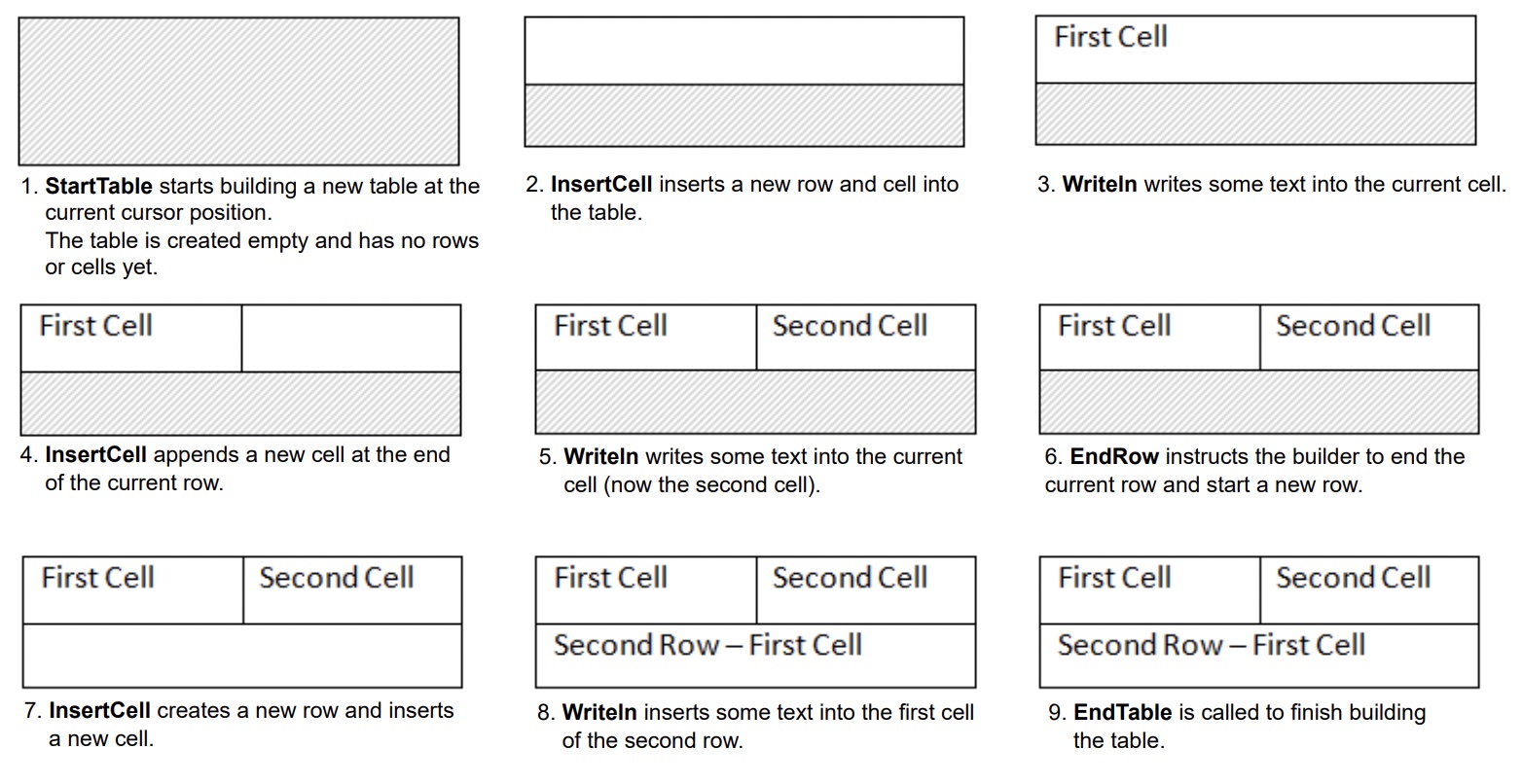Analyzing your prompt, please hold on...
An error occurred while retrieving the results. Please refresh the page and try again.
Aspose.Words, kullanıcıların bir belgede sıfırdan tablolar oluşturmasına olanak tanır ve bunu yapmak için birkaç farklı yöntem sunar. Bu makale, her yöntemi kullanarak belgenize biçimlendirilmiş tabloları nasıl ekleyeceğinize ilişkin ayrıntıların yanı sıra makalenin sonunda her yöntemin karşılaştırmasını sunar.
Yeni oluşturulan tabloya Microsoft Word’te kullanılanlara benzer varsayılan değerler verilir:
| Tablo Özelliği | Aspose.Words’te varsayılan |
|---|---|
Border Style |
Single |
Border Width |
1/2 pt |
Border Color |
Black |
Left and Right Padding |
5.4 pts |
AutoFit Mode |
AutoFit to Window |
Allow AutoFit |
True |
Aspose.Words’te kullanıcılar DocumentBuilder‘yi kullanarak bir belgede tablo oluşturabilirler. Tablo oluşturmanın temel algoritması aşağıdaki gibidir:
Önemli ayrıntılar:
Tablo oluşturma süreci aşağıdaki resimde açıkça görülebilir:

Aşağıdaki kod örneği, varsayılan biçimlendirmeyle DocumentBuilder kullanarak basit bir tablonun nasıl oluşturulacağını gösterir:
Aşağıdaki kod örneği, DocumentBuilder kullanılarak biçimlendirilmiş bir tablonun nasıl oluşturulacağını gösterir:
Aşağıdaki kod örneği, DocumentBuilder kullanılarak iç içe tablonun nasıl ekleneceğini gösterir:
Belirli bir konuma yeni bir Table düğümü ekleyerek tabloları doğrudan DOM’e ekleyebilirsiniz.
Tablo düğümü oluşturulduktan hemen sonra tablonun tamamen boş olacağını, yani henüz satır ve hücre içermediğini lütfen unutmayın. Bir tabloya satır ve hücre eklemek için uygun Row ve Cell alt düğümlerini DOM’e ekleyin.
Aşağıdaki kod örneği, uygun alt düğümleri belge ağacına ekleyerek sıfırdan yeni bir tablonun nasıl oluşturulacağını gösterir:
Aspose.Words, InsertHtml yöntemini kullanarak bir HTML kaynağından bir belgeye içerik eklenmesini destekler. Giriş, tam bir HTML sayfası veya yalnızca kısmi bir pasaj olabilir.
Kullanıcılar InsertHtml yöntemini kullanarak <table>, <tr>, <td> gibi tablo etiketleri aracılığıyla belgeye tablo ekleyebilirler.
Aşağıdaki kod örneği, HTML etiketlerini içeren bir dizeden belgeye tablonun nasıl ekleneceğini gösterir:
Çoğu zaman bir belgede zaten var olan bir tabloyu temel alarak bir tablo oluşturmanız gerekir. Tüm biçimlendirmeyi korurken bir tabloyu çoğaltmanın en kolay yolu, Clone yöntemini kullanarak Tablo düğümünü klonlamaktır.
Aynı teknik, mevcut bir satırın veya hücrenin kopyalarını bir tabloya eklemek için kullanılabilir.
Aşağıdaki kod örneği, düğüm oluşturucuları kullanılarak bir tablonun nasıl çoğaltılacağını gösterir:
Aşağıdaki kod örneği, bir tablonun son satırının nasıl kopyalanacağını ve tabloya nasıl ekleneceğini gösterir:
Veri kaynağınızdaki her kayıtla dinamik olarak büyüyen bir belgede tablolar oluşturmayı düşünüyorsanız yukarıdaki yöntem önerilmez. Bunun yerine Mail merge’in bölgelerle birlikte kullanılmasıyla istenilen çıktı daha kolay elde edilir. Bu teknik hakkında daha fazla bilgiyi Bölgelerle Mail Merge bölümünde bulabilirsiniz.
Aspose.Words, bir belgede yeni tablolar oluşturmak için çeşitli yöntemler sağlar. Her yöntemin kendine özgü avantajları ve dezavantajları vardır, bu nedenle hangisinin kullanılacağının seçimi genellikle özel duruma bağlıdır.
Tablo oluşturmanın bu yollarına daha yakından bakalım ve bunların artılarını ve eksilerini karşılaştıralım:
| Yöntem | Avantajları | Dezavantajları |
|---|---|---|
DocumentBuilder aracılığıyla |
Tabloları ve diğer belge içeriğini eklemenin standart yöntemi | Aynı oluşturucu örneğiyle aynı anda birçok tablo çeşidi oluşturmak bazen zor olabilir |
| DOM aracılığıyla | DocumentBuilder kullanmadan düğümleri doğrudan DOM’e oluşturup ekleyen çevreleyen kodla daha iyi uyum sağlar | Tablo “boş” olarak oluşturulmuştur: çoğu işlemi gerçekleştirmeden önce, eksik alt düğümleri oluşturmak için EnsureMinimum‘i çağırmanız gerekir |
| HTML’den | <table>, <tr>, <td> gibi etiketleri kullanarak HTML kaynağından yeni bir tablo oluşturabilir |
Mümkün olan tüm Microsoft Word tablo formatları HTML’ye uygulanamaz |
| Mevcut bir tabloyu klonlama | Tüm satır ve hücre biçimlendirmesini korurken mevcut bir tablonun bir kopyasını oluşturabilirsiniz | Tablo kullanıma hazır olmadan önce uygun alt düğümlerin kaldırılması gerekir |
Analyzing your prompt, please hold on...
An error occurred while retrieving the results. Please refresh the page and try again.